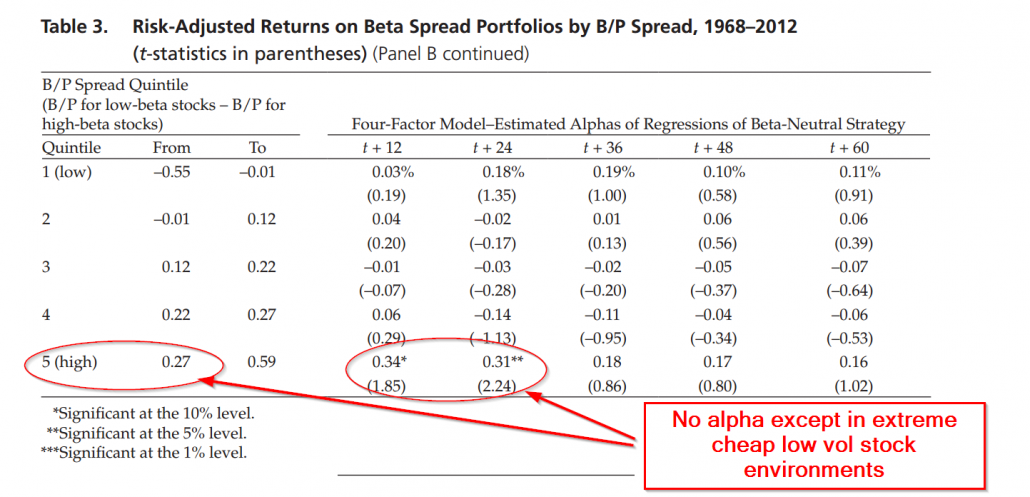Jack and I had the honor of attending the Evidence-Based Investing conference, hosted by the team at Ritholz Wealth Management.
Wow.
What a great event and a great group of inspiring investors and thinkers.
Abe, Meb, John, Mike, and I had the opportunity to chat about systematic investing. Mr. Lincoln was a little lost during the conversation, but that’s okay — he’s old.
One of the more “provocative” items we discussed was the use of low volatility as a signal for stock selection. Tom Brakke has me quoted as saying the following:
Right now, low-vol is expensive crap. You should be buying cheap crap.
Zero points for eloquence. Three points for simplicity.
At first glance, portfolios that sort on a low volatility signal have done well, historically. But further investigation into the subject suggests that a lot of the mojo in low-volatility is likely associated with the well established premias attached to value and momentum — not something incredibly unique and/or different. In fact, we covered a paper in May of this year (near the peak of low-vol relative performance) that makes this very point — low vol only adds a differentiated return when low vol stocks are cheap (quintile 5):

In practice, what does this mean? It means that if you already own value (which probably has quality mixed in) and momentum inside a broader diversified portfolio, the marginal benefit of adding low-vol seems pretty weak, in general. And the argument for adding low volatility exposure when low volatility stocks are generally expensive is a decidedly terrible idea (e.g., ask low vol investors how they feel over the last few months?).
Digging Deeper into Low Volatility Investing
We have written extensively on low volatility and the low volatility anomaly in particular.
If you are looking for a primer on low vol investing, we wrote here about why the low volatility anomaly exists, and Eric Falkenstein provided a brief history of low volatility investing. We even wrote about how to calculate volatility in excel so everyone had a general idea of what the finance geek world was talking about.
Without a doubt, low volatility is interesting — nobody can deny that fact. However, the pragmatic question is whether or not low volatility is such a compelling factor that it requires a serious change in portfolio construction. We think low volatility investing is marginally interesting relative to the core muscle movements of value and momentum. We put it on the same wavelength as quality — useful in the context of value and/or momentum, but not at the same level. Think junior varsity factor team, not the varsity factor team.
The low volatility anomaly also has some interesting relationships with firm characteristics and investor behavior. For instance, we wrote about a paper that explores the connection between volatility and short interest. We wrote here about why betting against beta may be connected to demand for lottery assets. Here is a post on how booms and busts in low volatility arbitrage activity may contain information for investors. We also wrote about the tactical use of low volatility in a portfolio. Finally, we even discussed the out of sample robustness issues in other markets.
We’ve done our own analysis as well. For example, an in-house simulation, which suggested one should never invest in high volatility stocks. This work led us to question whether low-volatility was a particular expression of simple value, so we did a simulation study looking at the relationship between low volatility and value. From a return perspective, low volatility doesn’t do much, however, low volatility does seem to have an edge in the risk management department. Of course, this edge depends on low volatility being cheap — which it isn’t today.
Bottom line: The low volatility anomaly is complex, uncertain, and may not be worth the brain damage for most investors. Unless you are a sophisticated buyer, can ask the right questions, and understand explicitly how the allocation adds value to a diversified global portfolio with value and momentum already in place, we’d recommend that investors remain skeptical when a new low-volatility fund wholesaler shows up to the door.
About the Author: Wesley Gray, PhD
—
Important Disclosures
For informational and educational purposes only and should not be construed as specific investment, accounting, legal, or tax advice. Certain information is deemed to be reliable, but its accuracy and completeness cannot be guaranteed. Third party information may become outdated or otherwise superseded without notice. Neither the Securities and Exchange Commission (SEC) nor any other federal or state agency has approved, determined the accuracy, or confirmed the adequacy of this article.
The views and opinions expressed herein are those of the author and do not necessarily reflect the views of Alpha Architect, its affiliates or its employees. Our full disclosures are available here. Definitions of common statistics used in our analysis are available here (towards the bottom).
Join thousands of other readers and subscribe to our blog.


